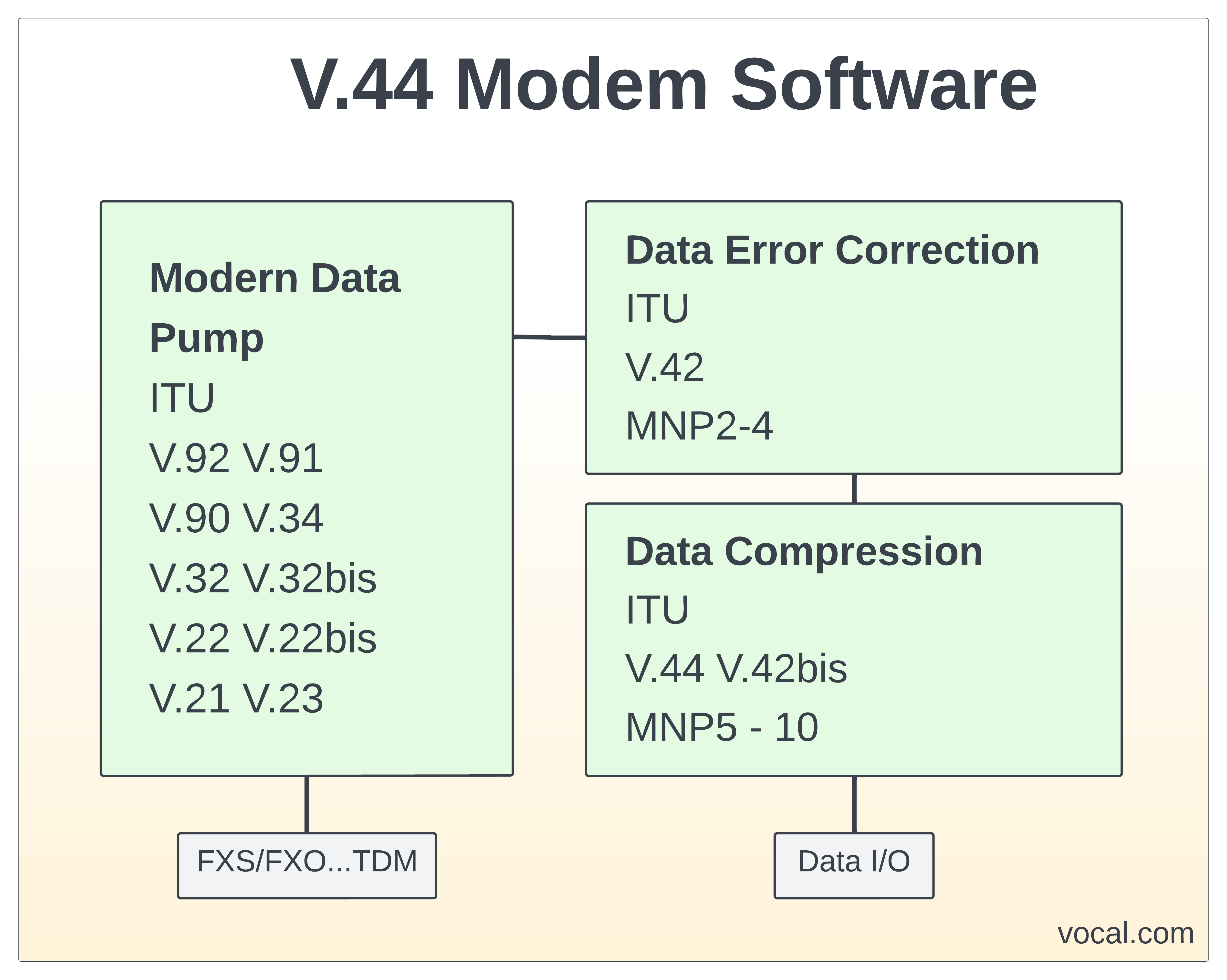 V.44 data compression software implements ITU-T V.44 which defines a lossless procedure for modems used with V-series data circuit-terminating equipment (DCEs) as well as packet networks. The principal characteristics are:
V.44 data compression software implements ITU-T V.44 which defines a lossless procedure for modems used with V-series data circuit-terminating equipment (DCEs) as well as packet networks. The principal characteristics are:
- Compression procedure to encode strings of characters input to DTE as binary codes of variable length
- Decoding procedure to recover the strings of characters from received binary codes of variable length
- A string-building mechanism to rapidly extend existing strings
- An automatically invoked transparent mode of operation when uncompressible data are detected
Virtual Modem over IP
VOCAL’s SIP Software modem (MoIP or V.MoIP) solution provides developers a range of solutions to connect legacy dial up modems to modem infrastructure. Unlike other virtual modem designs, the SIP software modem can communicate with a physical modem at the far end using a VoIP service over an IP network.
VOCAL’s V.44 software is optimized for performance on leading DSP architectures and processors from TI, Intel, ADI, AMD and other vendors. Our modem software may be licensed standalone, as a library or a complete design. Custom solutions are also available. The libraries are modular and can be executed as a single task under a variety of operating systems or standalone with its own microkernel. Contact us to discuss your V.44 data compression application requirements.
V.44 Data Compression
For correct operation of the V.44 data compression function, it is necessary that an error-correcting procedure be implemented between the two entities using V.44. In the case of Vseries Recommendations, the Link Access Procedure for Modems (LAPM) error-correcting procedures defined in Recommendation V.42 or the error-correcting procedures in Recommendations V.76 or V.120 are implemented. Undetected bit errors cause mis-operation of the data compression function. Use of a 32-bit frame check sequence (FCS), as defined in ISO/IEC 13239, substantially reduces the possibility of such errors, and may be desirable in environments with severe impairments. This 32-bit FCS is an option in V.42 LAPM. The V.44 data compression function is used with an error-correcting DCE. The elements of an error-correcting V-series DCE are specified in Recommendation V.42.
The V.44 data compression function consists of an encoder and a decoder. A data connection, in general, supports data transmission in both directions, and thus can support compression in both directions. As such, each data connection peer can have an encoder and a decoder. The encoder transfers compressed data to its peer decoder at the other end of the connection, and the decoder decompresses the compressed data received from its peer encoder. The encoder-decoder pair for each direction must have coordinated compression parameter values, established through negotiation; however at any one end, the encoder and decoder parameter values may differ, since they refer to different directions of transmission.
Characters from the DTE input to the V.44 encoder are matched against any previously identified strings of characters. If a string is matched, the codeword representing the string is transferred, and then an attempt is made to extend the matched string to encode additional characters and create a new and longer string. If no string match is found, the ordinal corresponding to the first character is transferred.
The V.44 encoder continually adds to its set of strings available for matching, by placing input characters into the history and by adding nodes to the node-tree. When either of these becomes full, the dictionary is reinitialized, and the encoding operation continues as before. The decoder creates strings that replicate the strings created by its peer encoder, using the same assigned codewords. By using these strings, it decompresses the received compressed data stream. The decoder dictionary is reinitialized upon receipt of a REINIT control code.
More Information
- Data Modem
- 56K Modem Software
- Data Modulation Software
- Data Protocol Software
- Command Set Controller Software
- V.22bis / V.22 / Bell 212 / V.23 / V.21 / Bell 103 Modem Software
- V.32bis and V.32 Modem Software
- V.34 Modem Software
- V.42 / V.42bis Software
- V.90 Modem Software
- V.91 Modem Software
- V.92 Modem Software
- V.92 Modem-on-Hold, PCM upstream and Quick Connect Features
VOCAL’s optimized software is available for the above platforms. Please contact us for specific V.44 supported platforms.
